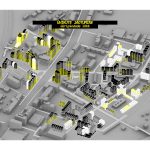Helena Rummo
- Faculty of Architecture
- Architecture and Urban Design
- ma
- Fixed Abode
- Tutor(s): Martin Melioranski, Raul Kalvo
The focus of the master’s thesis is ownership – a complex in which emotional and rational polarity are fused into one whole. On the one hand, housing is one of the largest investments in a person’s life, on the other hand, it is a source of security and belonging. In Estonia, three quarters of people are homeowners expressing the strong belief in ownership. The emotional security is guaranteed, but often people’s living conditions do not correlate with their needs.
The aim of the master’s thesis is to find a way to review the problems arising from the rigidity of private property and to play through
the scenario in which it is possible to achieve a sense of security and feeling of home by making property participatory.

My approach to such topics lies in abstraction and blurring the borders of private property. The planning is equivalent to the total shares in the region and residents act as shareholders, who get the right to own a specific proportion of planning from the share lot. The ownership of the specific property is shifted to owning a proportion of the estate.
The new ownership system gives a possibility to create specific dwellings in accordance to the different stages and requirements of people’s lives to avoid the formation of unified apartments.

The project is solved on the scale of city planning on both sides of Pärnu maantee in Kitseküla. By compacting the Kitseküla region to the density of the central city it would result in tenfolding the population. Approximately 300 apartments are present in the area, which would increase to 2000 with the establishment of the new planning.
The establishment of the system requires a big spectrum and constantly circulating units in order to have a cycle between the dwellings. This is achieved through a proportion of rental units with a limited rental period, allowing for a subtle change and cycle of tenants in the planning area.


On the other hand, such a system creates a possibility to have an increased freedom in owning. While in the Nordic countries 30% of the people move in the duration of five years, in Estonia this proportion is 5%. The people are being tied to the private property as selling and exchange transactions are risky and stressful. Often people’s needs are not in a correlation to what they own.
The planning gives an opportunity to change the dwelling inside the planning area according to their needs. Furthermore the system gives an opportunity to be more mobile and free, being free from the real estate market situation and the volatility of it. In the project I play through three quarters: public, domestic and elderly.


